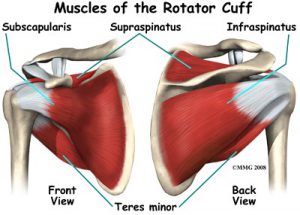One of the three most common areas for which our clients seek our help is at the shoulder. Rotator cuff tendinitis is a common shoulder problem. Or is it?
Allow me to be coy for a moment. Yes, the rotator cuff is a critical part of the shoulder, and it plays a very important role on the most mobile ball and socket joint in the human body. The cuff is made up of four muscles. Each originates on the shoulder blade and connects to the upper arm (Figure 1). Thus, they are responsible for controlling the position of the ball on the socket.

If the rotator cuff doesn’t do its job well, the humeral head – the ball in the ball and socket joint – can put increased pressure on the shoulder components. This can result in inflammation, tendinitis, bursitis, and impingement. Most of the time, this development is a gradual process, and because the areas affected are limited in blood supply, irritation is common and healing is slow.
If you have ever received treatment for any musculoskeletal condition at Kinetic Edge, you know that the explanation I offered in the previous paragraph, while understandable, is probably a bit too simplistic.
You see, normal and pain-free function is not simply the result of one part acting effectively on another. Instead, function is a delicate interplay of many parts of the kinetic chain all working together in synchrony so that very complex activities look way easier to accomplish than they really are. Like every other joint in the human body, appropriate shoulder function requires help from the shoulder’s friends and neighbors, near and far.
As a result, treatment of rotator cuff problems require a focus of the entire kinetic chain to make sure that you move better, feel better, and function better. Rotator cuff issues are a shoulder problem, but they are also an entire kinetic chain problem.
Traditional treatments for rotator cuff issues usually involve methods of reducing inflammation (i.e. medications, ice, ultrasound, etc.). Once inflammation is reduced, rotator cuff strengthening is emphasized. This often makes you feel better, although it may take some time, and once you feel better, you’re discharged.
Unfortunately, many… and maybe even most of you that receive that treatment will have future problems if the functional friends of the shoulder are ignored. It will likely surprise you that in my experience a majority of the people I’ve helped with shoulder issues have had limited thoracic spine and hip mobility.
If you’ve had shoulder issues in the past or are experiencing them right now, seek help from a physical therapist that is a functional movement specialist. To help you get well and stay well, your physical therapist must understand that the most important final step of rehabilitation requires a focus on things like the scapular muscles, which are near to the shoulder, as well as areas that are not so near to the shoulder like the thoracic spine, the hips, and the feet.
This month, we’re offering free shoulder screens. Call us today to get a complimentary, brief (15 minute), no strings attached assessment with one of our physical therapists to help you understand if your shoulder needs a little help from its friends – the shoulder blade, thoracic spine, hips, and feet.
Email us or call 866-588-0230 to claim your shoulder assessment today!



